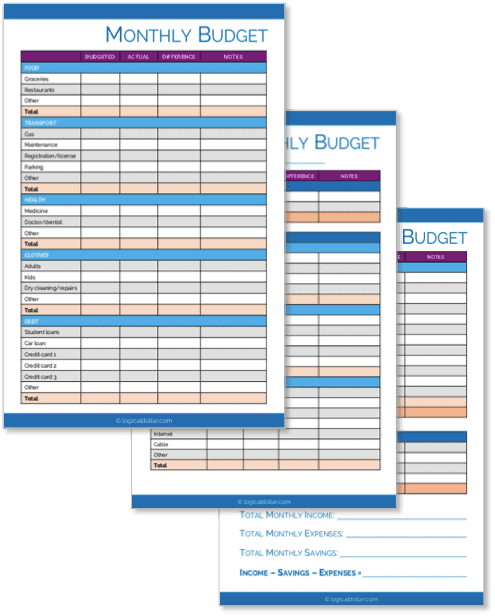The 60/20/20 rule is a popular guideline that suggests spending 60% of your money on what’s important, 20% on financial milestones, and 20% on anything else you want.
This rule can be applied to many areas of life, including your work, personal time, and finances.
In this blog post, we will discuss how you can use the 60/20/20 rule to improve your productivity and achieve your goals.

TAKE BACK CONTROL OF YOUR FINANCES
Our free budget planner will help you to quickly and easily take control of your money – instead of it controlling you.
Get it free for a limited time!
You’ll also join our mailing list to get updates on how to manage your money – unsubscribe at any time at the end of each email.
What is the 60/20/20 rule?
The 60/20/20 rule is a simple budgeting system that helps you to focus on what’s financially important. It assigns 60% of your income to expenses, 20% of your income to financial goals and 20% of your income to discretionary spending.
It’s less complicated than other budgeting systems because it only has three categories that focus on your essentials, future goals, and current lifestyle.
To go into some more detail, 60% of your income will go towards basic living expenses, including your mortgage or rent, food, transportation, and utilities.
Meanwhile, 20% should be put into savings or investments for your future. This could include retirement accounts, an emergency fund, or a down payment on a house. It can also be used to pay off debts such as student loans or credit card debt.
The final 20% is for anything else you want, including travel, entertainment, and clothes. This category is important because it allows you to spend money on things that make you happy and improve your quality of life.
Pros of the 60/20/20 rule
The 60/20/20 rule is a simple and effective way to budget your money. It’s easy to understand and follow, which makes it a great option for people who are new to budgeting. This system also leaves room for flexibility. If you have a month where you need to spend more than usual, you can adjust your budget accordingly.
The 60/20/20 rule can also help you to achieve your financial goals. By applying the 60/20/20 rule in investing, you can quickly build up your nest egg. This system can be a great way to pay off debt because it allows you to focus on one debt at a time.
Finally, you can conveniently use the 60/20/20 rule in business by allocating 60% of your time to revenue-generating activities, 20% to marketing, and 20% to administrative tasks. This will help you to focus on the most important aspects of your business and grow your company.

Cons of the 60/20/20 rule
The main complaint that people have with the 60/20/20 rule is that it’s a bit too simplified. This system doesn’t account for unexpected expenses, such as car repairs or medical bills. It also does limit your discretionary spending quite a bit.
That is, another downside of the 60/20/20 rule is that it doesn’t leave much room for luxury items. If you want to travel or buy a new wardrobe, you’ll need to save up for it in advance. This can be difficult for people who live paycheck to paycheck.
How to get started with the 60/20/20 rule
If you’re interested in trying out the 60/20/20 rule, you’ll need to start by checking in with your current finances. Then you should work on devising a plan to track your spending so that you can make sure you’re on track with your financial goals.
Here’s a step-by-step guide to getting started with this budgeting method:
1. Get a good sense of your income and expenses
As with any budget, it’s important to assess how much money is coming in and out to know who you’ll need to adjust moving forward.
You can do this by taking a blank budget worksheet or using a budgeting app to track your income and expenses for at least one month. This will give you a good idea of where your money is going and how much wiggle room you have in your budget.
You can also look at your previous month’s spending by reviewing your bank and credit card statements. This can be helpful if you’re not sure where to start with tracking your expenses.
Related: 13 Best Budgeting Apps for Couples to Manage Their Money Together
2. Identify your fixed and variable costs
Once you have a good idea of your spending, you’ll need to identify which expenses are fixed (like rent or mortgage payments) and which ones are variable (like groceries or utility bills).
This will help you to see which expenses are non-negotiable and which ones you have more control over. It can also be helpful in creating a budget that works for your lifestyle.
For example, if you have a high mortgage payment, you may need to cut back on other expenses to make ends meet. On the other hand, if you have a low mortgage payment, you may have more room in your budget to spend on things like investing or entertainment.

3. Decide how much to save and invest
Once you’ve identified your fixed and variable costs, you can start to allocate money to savings and investments.
As a general rule of thumb in the 60/20/20 rule, you should aim to save at least 20% of your income. However, this may not be possible for everyone. If you’re just starting out, you may need to save a smaller percentage of your income until you’re in a better financial position.
4. Categorize your expenses
There are three categories that you’ll need to consider when budgeting with the 60/20/20 rule:
- Necessities include your fixed costs, like rent or mortgage payments, as well as variable costs that are essential to your lifestyle like groceries and utility bills.
- Savings and investments include any efforts you’re making to grow your wealth, like contributing to a 401(k) or IRA. It also includes any payments you’re making against your debts.
- Lifestyle choices are the remaining expenses in your budget, like travel, entertainment, and dining out. This is also a savings category as well because you may want to save up for a bigger purchase, like a new car or a down payment on a house.
5. Set up your tracking systems
Once you’ve decided how much you’re going to allocate to each category, you’ll need to set up a system to track your spending.
This can be as simple as creating a budget in a spreadsheet (these free budget printables can help you out with that) or using an app like Personal Capital. Whichever method you choose, make sure it’s one that you’ll be able to stick with.
Without a way to track how you’re spending your money, it will be difficult to stay on budget or see any substantial benefits from this method.

6. Adjust and improve as needed
The final step is to adjust and improve your budget as needed. As your income or expenses change, you’ll need to revisit your budget to make sure it’s still accurate.
You may also find that you need to adjust your savings goals as you get closer to retirement or have other financial goals in mind.

MANAGE YOUR MONEY LIKE A BOSS
Managing your money effectively can literally change your life. And starting a budget using our budget planner is the first step towards you doing just that.
Get it free for a limited time!
You’ll also join our mailing list to get updates on how to manage your money – unsubscribe at any time at the end of each email.
Tips to stick with the 60/20/20 rule
If you want to stay committed to the 60/20/20 rule, there are a few things you can do to make it easier.
1. Start small
If you’re not used to budgeting, start by allocating a smaller percentage of your income to savings and investments. As you get more comfortable with the process, you can increase the amount you’re setting aside.
Try to increase your savings by at least one percent each month until you’re able to save 20% of your income.
Find out more: The Household Budget Percentages You Should Be Using
2. Focus on improving one category at a time
Another way to start small is to focus on one area of your budget, like lifestyle choices. If you’re not used to tracking your spending, this can be a good place to start. Once you have a handle on your lifestyle expenses, you can start to focus on other areas of your budget.

3. Have an accountability partner
If you find it difficult to stick to a budget, consider finding an accountability partner. This can be a friend, family member, or financial advisor. Having someone to help you stay on track can make a big difference in your ability to stick to the 60/20/20 rule.
4. Set a clear goal for yourself
Having a reason and a goal for following the 60/20/20 rule can also help you stay motivated. Without a clear goal, it’s easy to lose sight of why you’re budgeting in the first place.
For example, if your goal is to retire by a certain age, you’ll need to make sure you’re saving enough money each month. Or, if you want to buy a house, you’ll need to focus on building up your savings.
No matter what your goal is, make sure it’s something that you’re passionate about and that will keep you motivated to stay on budget.
You may also be interested in: 13 Best Budget Planners to Get Financially Organized
5. Schedule your budget reviews in advance
If you’re not used to tracking your spending or regularly going into your bank accounts, it’s going to be difficult to make a habit out of these tasks.
To make it easier, schedule your budget reviews in advance. This can be once a week, bi-weekly, or monthly. Put it in your calendar and treat it like any other appointment you have.
This will help you get into the habit of regularly reviewing your budget and making sure you can track your process, which is both practical and motivational.

6. Plan a reward for yourself
Last but not least, plan a reward for yourself once you reach your goal. This can be something small, like a new pair of shoes, or something bigger, like a weekend getaway. Having something to look forward to will help you stay on track and motivated to follow the 60/20/20 rule.
This can be something big, like a vacation once you reach one year of following the plan. Or you could plan a monthly treat for every month that you’re on a budget.
No matter what your reward is, make sure it’s something that you’ll actually enjoy and that will help you stick to your goal.
Alternatives to the 60/20/20 rule
Some common alternatives to the 60/20/20 rule include the 80/20 plan, the 50/20/30 rule, and the zero-sum method. These popular budgeting strategies can be a good fit for different types of people, depending on their financial goals.
The 80/20 plan is the simplest of the three alternatives. This plan encourages you to deposit 20% of each paycheck into a savings account. Many people further simplify this method by creating an automatic transfer from their checking to their savings account.
The 50/20/30 rule is a more detailed approach that allocates your income into three distinct budget categories: essential expenses, financial goals, and lifestyle choices. It’s a slight variation of the 60/20/20 rule that is ideal for people who want more immediate spending money (such as younger adults with more time to save money down the line).
The zero-sum method is one of the best ways to take a consistent income (such as if you always earn, say, $4,000 every month) and divide it into delegated categories. This method is very effective for people who want to have specific control over where their money is going and it is what people often refer to as a typical budget structure.
Where should I put my savings with the 60/20/20 rule?
The best ways to save your money when using the 60/20/20 rule are to put your money in a high-yield interest savings account, invest it in low-risk mutual funds, or invest it in an asset such as real estate or a business.
Deciding on the best investment space will depend on a few things, including your financial goals, your risk tolerance, and your current liabilities or debts. You’ll want to get really clear on these factors before deciding where to invest your money.
If you’re looking for a place to start, I recommend opening a high-yield interest savings account. This will allow you to grow your money without taking on too much risk. Once you’ve built up some savings, you can start exploring other investment options that fit your goals and risk tolerance.
CIT Bank – Money Market Account
Our pick: Best high interest savings account
Why? Well, because it’s got:
- 1.00% interest (over 11 times higher than the national average)
- No fees and only a $100 minimum deposit
- FDIC insured, meaning your money’s safe
If you have high-interest debt such as credit card debt, I recommend using the snowball method to pay it off. This means you’ll focus on paying off your smallest debts first and then work your way up to the larger ones.
The reason this method is effective is because it gives you quick wins that help keep you motivated to stay on track with your debt repayment plan. Plus, it can save you money in interest charges over time.
What if I can’t save 20% of my income?
If you can’t save 20% of your income, that’s okay! You can still follow the 60/20/20 rule by allocating a smaller percentage of your income to savings. For example, you could put 15% of your income into savings and use the other 85% for expenses and debt payments.
The most important thing is that you’re starting to save and build up your emergency fund. From there, you can start working on your other financial goals, like paying off debt or investing in a long-term goal.
Is it hard to stick to the 60/20/20 rule?
The 60/20/20 rule is a great way to start budgeting, but it can be difficult to stick to at first. I recommend starting small and gradually increasing your savings over time. This way you won’t have such a shock in your lifestyle that could make it difficult to stick to your budget.
Some additional things you can do to make your budgeting journey easier include automating your finances, tracking your progress, and spending time learning about personal finance.
Automating your finances means setting up automatic transfers into your savings account so you don’t have to think about it.
Tracking your progress means regularly reviewing your budget to see where you can make adjustments.
And finally, learning about personal finance will help you understand the concepts behind budgeting and investing so you can make smarter decisions with your money.

READY FOR MORE?
Join thousands of subscribers in getting regular tips in your inbox on how to take control of your finances and save more money – and, for a limited time, get our free budget planner as a gift!
You’ll also join our mailing list to get updates on how to manage your money – unsubscribe at any time at the end of each email.






